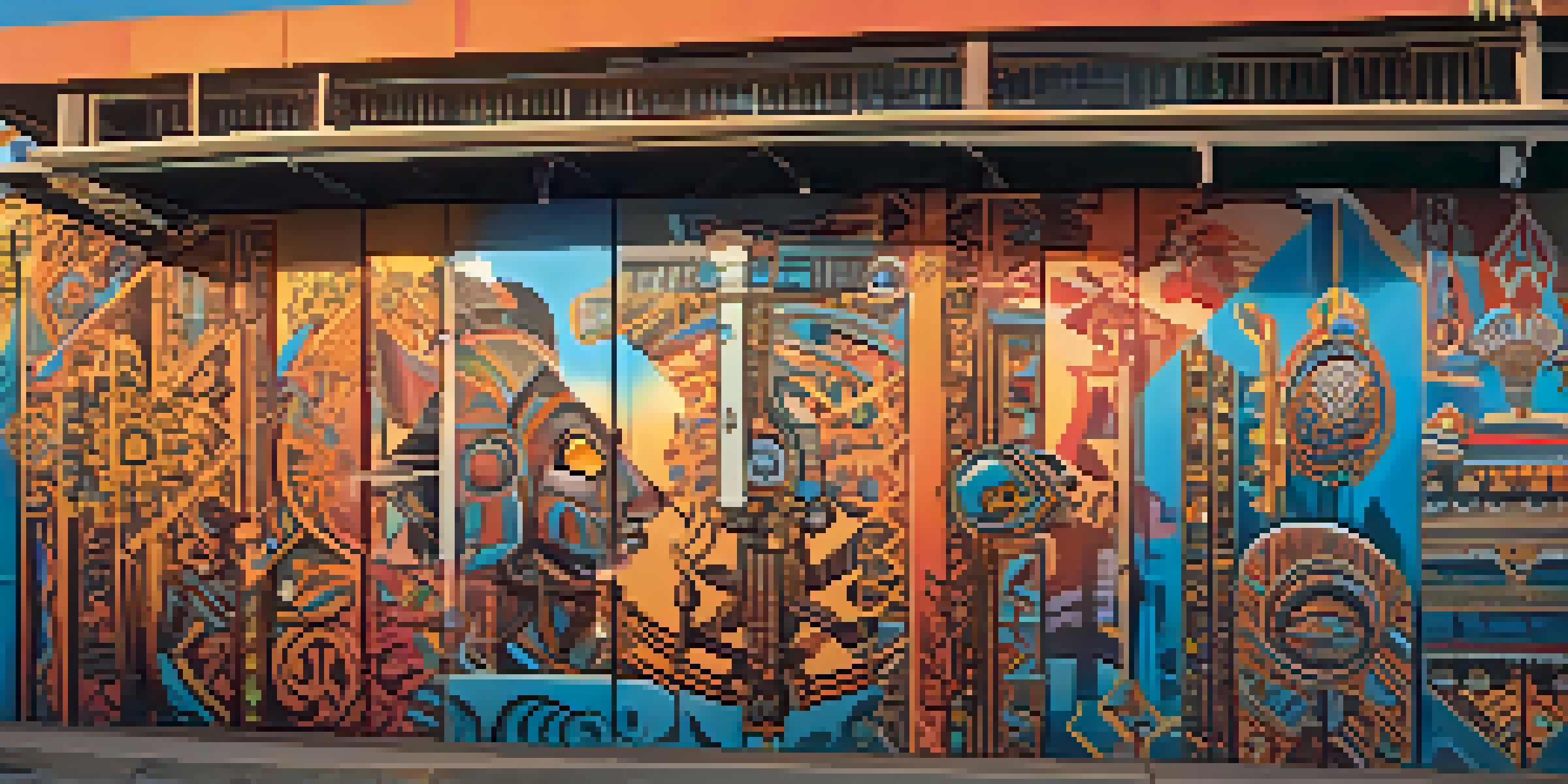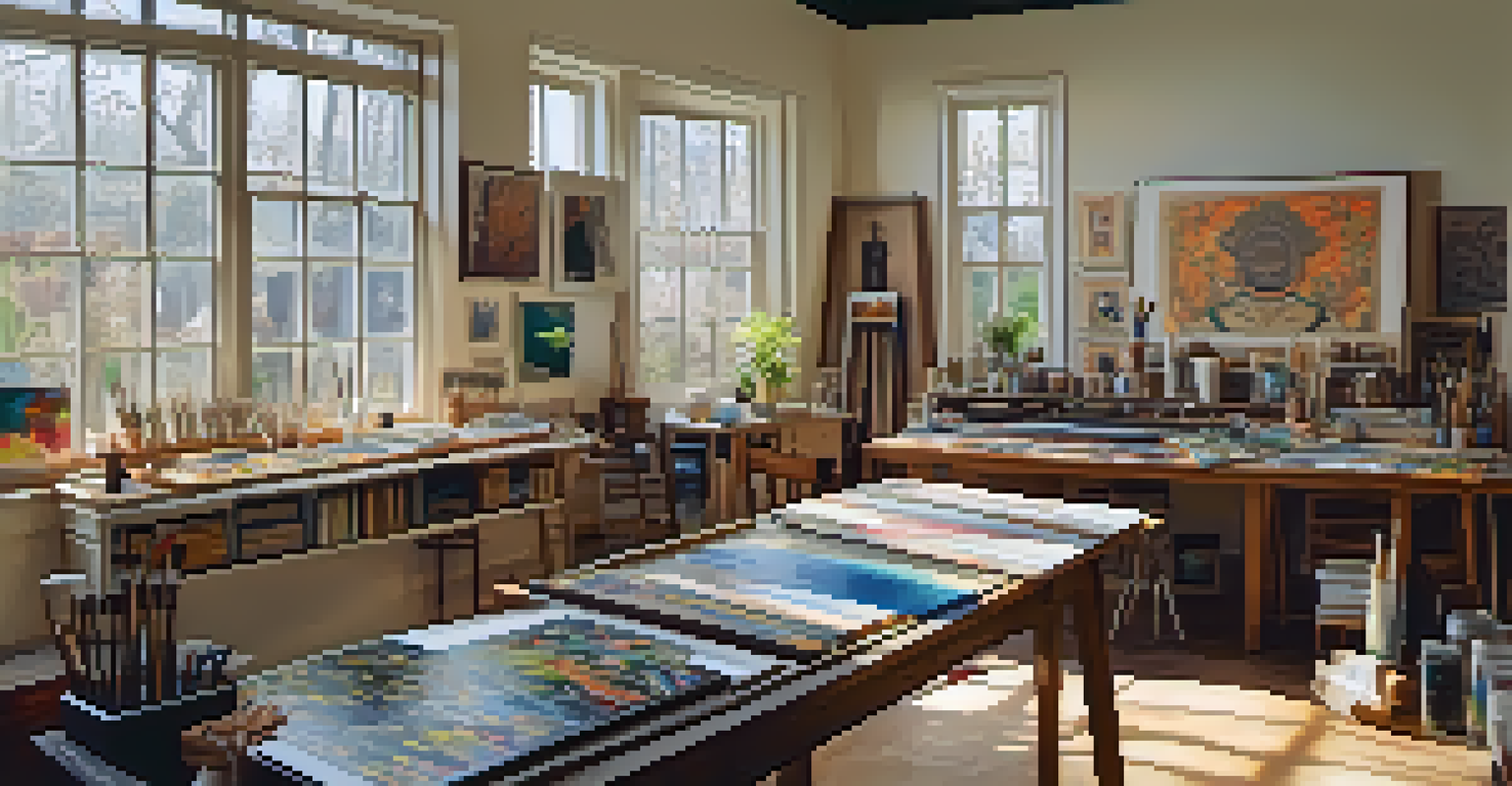Cultural Appropriation in Modern Art Movements Explained

Defining Cultural Appropriation in Art
Cultural appropriation refers to the adoption of elements from one culture by another, often without permission or understanding. In the art world, this can manifest when artists use motifs, symbols, or styles from cultures that are not their own. This practice can lead to a commodification of cultural expressions, stripping them of their original significance.
Art is the most beautiful of all lies; it is a reflection of culture, identity, and the human experience, and it must be treated with respect.
For instance, when a contemporary artist creates a piece inspired by indigenous designs, it may lack the context and meaning that those designs hold within the source culture. This can be particularly problematic if the originating culture has historically faced oppression or marginalization. Therefore, understanding cultural appropriation in art is crucial for fostering respect and authenticity.
Moreover, cultural appropriation can lead to a power imbalance, where the appropriating culture gains visibility and commercial success while the original culture remains overlooked. This dynamic raises important questions about ownership and representation in the art community.
Historical Context of Cultural Exchange
Cultural exchange has always played a role in art, shaping movements and styles throughout history. From the Renaissance's engagement with classical antiquity to the Impressionists' fascination with Japanese woodblock prints, artists have borrowed and adapted ideas across cultural lines. However, the context of these exchanges is vital.

Historically, some cultures have had the power to share and influence while others have been silenced or marginalized. When examining these dynamics, it becomes evident that the impact of cultural exchange can differ greatly depending on who is borrowing from whom. Acknowledging this history helps clarify the nature of cultural appropriation versus appreciation.
Cultural Appropriation Explained
Cultural appropriation in art occurs when artists adopt elements from other cultures without permission or understanding, often leading to a loss of original significance.
This historical lens also highlights the importance of dialogue and collaboration between artists from different backgrounds. When done respectfully, cultural exchange can lead to enriching artistic innovations that honor the origins of the influences.
Cultural Appropriation vs. Cultural Appreciation
While cultural appropriation often leads to exploitation, cultural appreciation is rooted in respect and understanding. The distinction lies in the intent behind the use of cultural elements and the recognition of their significance. An artist who seeks to learn about and celebrate another culture, collaborating with its members, exemplifies appreciation.
Cultural appropriation is a form of theft, where one culture takes the symbols and practices of another without understanding their significance.
For example, an artist might create a piece that incorporates traditional motifs after thoroughly researching their meanings and consulting with cultural representatives. This approach not only honors the source culture but also enriches the artist’s work with deeper significance.
Conversely, when cultural elements are used solely for aesthetic purposes, without acknowledgment or respect, it veers into appropriation. This difference is essential for artists looking to engage with diverse cultures responsibly.
Modern Art Movements and Cultural Appropriation
In recent years, various modern art movements have sparked conversations around cultural appropriation. For instance, street art has frequently borrowed from indigenous and marginalized cultures, prompting debates about the ethics of such practices. As artists gain visibility and platforms, the scrutiny on their influences intensifies.
Take the case of graffiti art, which often incorporates symbols from various cultures. While some artists aim to highlight social issues, others may inadvertently perpetuate stereotypes or misrepresent the cultures they draw from. This complexity illustrates the fine line artists walk in their creative processes.
Distinguishing Appropriation and Appreciation
Cultural appreciation involves respectful engagement and collaboration with the source culture, while appropriation typically lacks acknowledgment and context.
Modern art movements must navigate these challenges, balancing innovation with sensitivity. As society becomes more aware of these issues, artists are increasingly encouraged to reflect on their influences and address cultural contexts in their work.
Impact of Social Media on Awareness
Social media has become a double-edged sword in discussions of cultural appropriation in art. On one hand, platforms like Instagram and Twitter allow artists to share their work widely, potentially amplifying voices that have been historically marginalized. On the other hand, these platforms also serve as spaces for critique and accountability, where cultural appropriation can be called out in real-time.
For example, an artist may post a piece that draws from another culture, only to face backlash from social media users who feel disrespected. This immediate feedback loop can educate artists about the implications of their choices, prompting them to rethink their approach to cultural influences.
Consequently, social media plays a pivotal role in shaping conversations around art and culture, encouraging artists to engage in more thoughtful practices. It also empowers audiences to participate actively in discussions about representation and respect.
The Role of Education in the Art Community
Education is key to addressing cultural appropriation in modern art. By fostering awareness about different cultures and their artistic traditions, art institutions can help artists approach their work with greater sensitivity. Workshops, seminars, and courses that focus on cultural significance and ethical practices can cultivate a more inclusive art community.
For instance, programs that invite guest speakers from diverse backgrounds can provide artists with firsthand insights into the meanings behind cultural elements. This kind of engagement encourages artists to approach their work with authenticity and respect, empowering them to create art that genuinely honors its cultural roots.
Education's Role in Art Practices
Education in art institutions can foster awareness and sensitivity towards cultural significance, helping artists navigate the complexities of cultural influences responsibly.
Moreover, art schools can incorporate discussions about cultural appropriation into their curricula, preparing future artists to navigate these complex issues thoughtfully. By prioritizing education, the art community can work towards more ethical and inclusive practices.
Moving Towards Respectful Artistic Practices
As discussions around cultural appropriation continue to evolve, artists are encouraged to adopt more respectful practices. This includes conducting thorough research, seeking collaboration with cultural representatives, and being open to feedback. By doing so, artists can create work that resonates more deeply and authentically with their audience.
It’s essential for artists to ask themselves critical questions: Am I honoring the culture I’m drawing from? Have I consulted with members of that culture? By engaging in this reflective process, artists can better navigate the complexities of cultural influence and appropriation.

Ultimately, the goal is for art to serve as a bridge between cultures, fostering understanding and appreciation rather than exploitation. By prioritizing respect and empathy, the art world can move towards a more inclusive and equitable future.